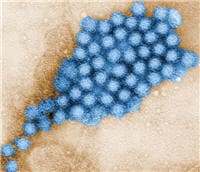General Information about Norovirus
General Information about Norovirus
Noroviruses are a group of viruses that cause gastroenteritis [gas-trō-en-ter-ī-tis] in people. Gastroenteritis is an inflammation of the lining of the stomach and intestines, causing an acute onset of severe vomiting and diarrhea. Norovirus illness is usually brief in people who are otherwise healthy. Young children, the elderly, and people with other medical illnesses are most at risk for more severe or prolonged infection. Like all viral infections, noroviruses are not affected by treatment with antibiotics. Norovirus infections spread very rapidly. Healthcare facilities and other institutional settings (e.g., daycare centers, schools, etc.) are particularly at-risk for outbreaks because of increased person-to-person contact.

For more images of this bacterium, search the Public Health Image Library
Symptoms of Norovirus
The symptoms of norovirus illness usually include nausea, vomiting, diarrhea, and some stomach cramping. Sometimes people also have a low-grade fever, chills, headache, muscle aches, and tiredness. People may suddenly feel very sick and vomit frequently or have several episodes of diarrhea, but most people get better within 1 or 2 days and they have no long-term health effects related to their illness. Diarrhea is more common in children and vomiting is more common in adults.
In some cases, people are unable to drink enough liquids to replace the liquids they lost because of frequent vomiting and diarrhea. This is called dehydration—the loss of a great deal of water from their body. Symptoms of dehydration include decreased urination, dry mouth and throat, and dizziness when standing up. In these cases, patients may be hospitalized and often given fluids through a tube placed in a vein.
Transmission of Norovirus
Noroviruses are found in the feces and vomit of infected people. This virus is very contagious and can spread rapidly throughout healthcare facilities. People can become infected with the virus in several ways:
- Having direct contact with another person who is infected (a healthcare worker, visitor, or another patient)
- Eating food or drinking liquids that are contaminated with norovirus
- Touching surfaces or objects contaminated with norovirus, and then touching your mouth or other food items
Prevention of Norovirus
In a healthcare facility, patients with suspected norovirus may be placed in private rooms or share rooms with other patients with the same infection. Additional prevention measures in healthcare facilities can decrease the chance of coming in contact with noroviruses:
- Follow hand-hygiene guidelines, and carefully washing of hands with soap and water after contact with patients with norovirus infection
- Use gowns and gloves when in contact with, or caring for patients who are symptomatic with norovirus
- Routinely clean and disinfect high touch patient surfaces and equipment with an Environmental Protection Agency-approved product with a label claim for norovirus
- Remove and wash contaminated clothing or linens
- Healthcare workers who have symptoms consistent with norovirus should be excluded from work
Norovirus prevention toolkit
- Overview: A Norovirus Outbreak Control Resource Toolkit for Healthcare Settings pdf icon[PDF – 306 KB]
- Poster: What healthcare providers should know pdf icon[PDF – 185 KB]
- Fact Sheet: Norovirus in Healthcare Facilities pdf icon[PDF – 419 KB]
- Sample Communication Framework: Suspected or Confirmed Norovirus Outbreaks pdf icon[PDF 649 KB]
- Worksheet: Acute Gastroenteritis / Norovirus Case Reports pdf icon[PDF – 253 KB]
- Key Infection Control Recommendations pdf icon[PDF – 1.05 MB]
- Sample Specimen Submission Framework: Resources during Norovirus Outbreaks pdf icon[PDF – 331 KB]
- Slide set: Norovirus Gastroenteritis Management of Outbreaks in Healthcare Settings pdf icon[PDF – 2.82 MB]
Additional Information


CDC Commentary: Norovirus – Protecting the Vulnerableexternal icon
Nearly two-thirds of norovirus outbreaks occur in nursing homes. Watch this video & learn how to help protect your most vulnerable patients.
Video 4:26 mins